What is the Childhood Education Program (CEP) at SMILE KID International School?
The Childhood Education Program is a structured and developmentally appropriate approach to teaching and nurturing young children—typically from 1.5 years to under 6 years of age—covering preschool, pre-kindergarten, and early primary levels. The program focuses on supporting each child’s physical, cognitive, emotional, and social development through engaging, age-appropriate learning experiences that lay a strong foundation for lifelong learning.
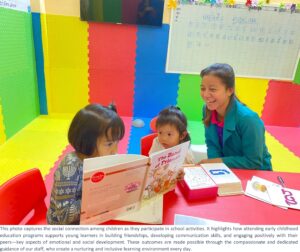
What are the main components of this Program?
The Childhood Education Program is designed to support the well-rounded development of young children. Its key components include:
- Early Learning and School Readiness: This component focuses on developing foundational skills in literacy, numeracy, and problem-solving. Children engage in age-appropriate activities that foster curiosity, critical thinking, and early academic habits, such as focus, persistence, and the ability to follow instructions. These experiences help prepare children for a smooth transition into primary education.
- Social and Emotional Development: This component supports children in understanding and managing their emotions, developing empathy, and building healthy relationships with others. Through cooperative play, guided interactions, and classroom routines, children learn important skills such as self-regulation, confidence, empathy, and respect for others. These skills lay the foundation for positive behavior, emotional well-being, and successful social interactions throughout life.
- Language and Communication Skills: This component focuses on developing children's abilities to listen, speak, and express themselves clearly, as well as introducing early reading and writing Language development is supported through engaging activities such as songs, storytelling, group discussions, and conversations, helping children expand their vocabulary, improve comprehension, and build confidence in communication.
- Physical and Motor Skill Development: This component promotes the growth of both gross motor skills (e.g., running, jumping, climbing) and fine motor skills (e.g., drawing, cutting, grasping). Children participate in daily physical activities, games, and hands-on tasks that help strengthen coordination, balance, and body awareness. These activities not only support physical health but also contribute to focus, independence, and readiness for academic tasks like writing.
- Creative Expression and Imagination: This component provides children with rich opportunities to explore art, music, dance, storytelling, and role-play. Through these activities, children are encouraged to express their thoughts, feelings, and ideas in imaginative ways. Hands-on creative experiences foster self-expression, build confidence, and support cognitive and emotional development—laying the groundwork for innovation and original thinking.
- Health, Nutrition, and Safety: This component emphasizes the importance of personal hygiene, healthy eating habits, and basic safety routines. Children learn daily practices such as handwashing, proper nutrition, and how to stay safe in different environments. The program also ensures a safe, nurturing, and inclusive learning environment where every child feels protected, valued, and supported in their overall well-being.
- Family and Community Engagement: This component recognizes the vital role of families and the wider community in a child’s development. It focuses on actively involving parents and caregivers in the learning process through regular communication, workshops, and participation in school activities. By building strong home-school partnerships, the program ensures consistent support for each child’s growth, while also encouraging a sense of belonging and shared responsibility within the broader community.
How Is the Process of the Childhood Education Program Carried Out?
The Childhood Education Program is implemented through a comprehensive, child-centered process designed to promote development across all learning domains. The key stages of the process include:
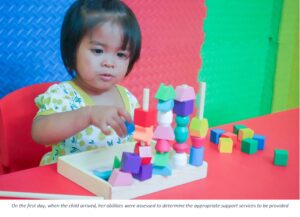
- Enrollment and Orientation: children are enrolled according to age group—typically from 1.5 to under 6 years old. An orientation session is held for both children and their parents to help them become familiar with the school environment, daily routines, teaching staff, and expectations. This initial stage helps build trust, reduce anxiety, and create a smooth transition into the learning setting.
- Initial Assessment: Teachers conduct a comprehensive assessment of each child’s developmental level across key areas: social, cognitive, motor, language, and emotional skills. This process helps identify each child’s individual strengths, learning needs, and any areas that may require additional support or intervention. The results guide personalized learning approaches and ensure that every child receives the care and attention they need to thrive.
- Curriculum Planning and Daily Activities: A developmentally appropriate curriculum is implemented, emphasizing learning through play, exploration, and meaningful interaction. Daily routines are thoughtfully structured to include activities that support all key areas of development—early literacy, basic math concepts, physical growth, creative arts, and social-emotional learning. This balanced approach helps nurture the whole child in a joyful and engaging environment.
- Individualized Support: Children who require extra assistance receive targeted support and tailored adaptations to ensure full inclusion and active engagement in all activities. Learning experiences and teaching methods are adjusted to align with each child’s unique pace, abilities, and needs, fostering confidence and maximizing their potential for growth.
- Family Involvement and Communication: Regular updates, parent-teacher meetings, and family engagement activities are organized to keep parents actively involved and well-informed about their child’s progress. Additionally, home-based learning strategies and resources are shared to reinforce and extend classroom experiences, fostering a strong partnership between school and family.
- Monitoring and Evaluation: Children’s progress is continuously tracked through observations, portfolios, and developmental checklists. Regular assessments are conducted to evaluate growth and inform any necessary adjustments in teaching strategies, ensuring that each child’s learning journey remains effective and responsive to their evolving needs
- Transition Preparation: As children approach school age, preparation for their transition into primary school begins. This process includes readiness assessments, classroom visits, and consultations with parents to ensure a smooth and confident shift. The goal is to support children emotionally and academically as they move to the next phase of their educational journey.
What Are the Approaches of the Childhood Education Program Applied?
The Childhood Education Program applies a range of evidence-based and child-centered approaches to ensure that young learners grow in all areas of development. In addition, we have used the Montessori Approach. It is based on the belief that children learn best when they are given the freedom to explore and choose activities within a carefully prepared, structured environment. The Montessori method promotes independence, self-discipline, and a love of learning. The Core Principles of the Montessori Approach.
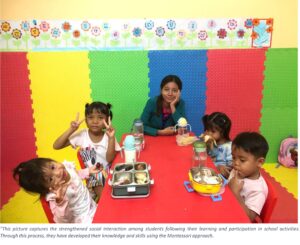
- Child-Centered Learning Each child is recognized as a capable and inquisitive learner. The Montessori method encourages children to progress at their own pace, selecting activities that align with their individual interests, developmental stage, and readiness—fostering independence and intrinsic motivation.
- Prepared Environment Montessori classrooms are intentionally designed to be calm, orderly, and accessible. They are equipped with carefully selected, age-appropriate learning materials that encourage hands-on engagement, independent exploration, and responsibility.
- Experiential, Hands-On Learning: Learning is facilitated through active manipulation of concrete materials. These materials are self-correcting, allowing children to independently identify and learn from their mistakes, thereby deepening comprehension and fostering problem-solving skills.
- The Role of the Teacher as a Guide Teachers in the Montessori setting serve as facilitators rather than traditional instructors. Through careful observation and individualized support, they guide each child’s learning journey while promoting autonomy, curiosity, and self-direction.
- Mixed-Age Classrooms: Montessori classrooms typically include a three-year age span, enabling children to learn collaboratively. Younger students benefit from peer modeling, while older students reinforce their own understanding through mentoring, thus cultivating leadership, cooperation, and empathy.
- Freedom Within Limits: Children are granted the freedom to make choices within clearly defined boundaries. This structure supports the development of independence, self-discipline, and respect for others and the learning environment.
- Holistic Development of the Child: The Montessori approach emphasizes the growth of the whole child—academically, socially, emotionally, and physically. The aim is to nurture confident, responsible, and well-rounded individuals who are prepared for lifelong learning and meaningful contributions to society.
What is the ENGLISH EDUCATION Program at SMIL KID INTERNATIONAL SCHOOL?
This program is specifically designed to support children from families facing difficult living conditions who are unable to send their children to school, despite their strong desire for their children to receive an education. Addressing this urgent need, the program prioritizes ensuring that these children have the opportunity to attend school and receive quality English education. This program serves as a valuable foundation, enabling children to develop their skills and prepare for future opportunities in the wider world.
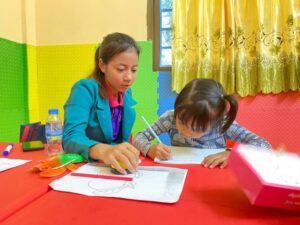
What are the main components of the English Education Program?
The main components of an English Education Program, especially in the context of inclusive and community-focused schools like SMILE KID International School, typically include the following:
- Language Skills Development: Strengthening listening, speaking, reading, and writing through interactive activities that build vocabulary and communication confidence.
- Curriculum Integration: Teaching English not only as a subject but also integrating it into other subjects like math and science, using child-centered themes relevant to daily life.
- Interactive Learning: Engaging students with songs, games, stories, role-play, and multimedia to make.
- learning enjoyable and effective.
- Early Childhood Language Enrichment: Introducing English naturally in preschool and kindergarten through songs, games, stories, and visual aids, focusing on phonics and basic communication.
- Inclusive and Differentiated Instruction: Tailoring activities for diverse learners, including children with disabilities or from disadvantaged backgrounds, using multisensory teaching methods.
- Teacher Training and Professional Development: Providing teachers with ongoing training in modern English teaching methods, inclusive education, and differentiated instruction.
- Student Assessment and Progress Monitoring: Continuously assessing students through classroom activities, observations, quizzes, and progress reports to support their development.
- Parental and Family Engagement: Encouraging parents to support learning at home with activities and communication tools to involve families actively.
- Life Skills and Global Competency: Using English to foster critical thinking, creativity, and cultural understanding, preparing students to apply language skills in real-life situations.
How Is the Process of the English Education Program Carried Out?
The English Education Program is carried out through a systematic process that begins with curriculum planning and teacher training. Teachers deliver interactive lessons using English both as a subject and a medium of instruction, adapting to the diverse needs of students. Students actively engage in listening, speaking, reading, and writing activities supported by various teaching resources. Continuous assessment monitors student progress, while parents and the community are involved to support learning at home. Finally, the program is regularly reviewed and improved based on feedback and student performance to ensure effectiveness and relevance. However, there are several critical steps that require careful consideration as mentioned below:
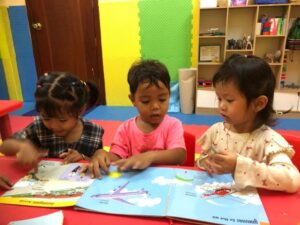
- Planning and Curriculum Design: Develop an inclusive curriculum that integrates language skills with other subjects, focusing on age-appropriate, real-life themes.
- Teacher Preparation: Train teachers on the curriculum, modern teaching methods, inclusive education, and assessment techniques.
- Classroom Implementation: Deliver lessons using interactive activities like stories, games, songs, and role-plays; use English both as a subject and instructional medium, adapting to diverse student needs.
- Student Engagement: Foster active participation through speaking, listening, reading, and writing exercises tailored to each learning level.
- Use of Resources: Utilize audio-visual aids, visual materials, communication tools, and hands-on activities to support learning.
- Continuous Assessment and Feedback: Monitor student progress through observations, quizzes, and assignments, providing timely feedback.
- Parental and Community Involvement: Encourage family support for learning at home and involvement in school activities.
- Review and Improvement: Regularly assess program effectiveness through teacher collaboration and student performance data, making necessary improvements.
What is the Special Education Program (SEP) at SMILE KID International School?
The Special Education Program (SEP) is a structured educational approach designed to meet the unique learning needs of children with physical, intellectual, emotional, behavioral, or developmental disabilities. Its primary goal is to provide inclusive, equitable, and individualized education that empowers every child to reach their fullest potential.
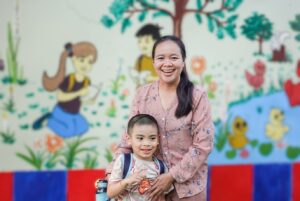
In addition to serving children with diagnosed disabilities, the program also supports students who struggle to keep up with school lessons or whose abilities fall below age-appropriate developmental levels. By offering tailored instruction, specialized support, and compassionate care, SEP ensures that all children receive the tools and encouragement they need to grow, succeed, and thrive alongside their peers.
What are the main components of this Program?
The program focuses on five key components to support children who have been identified as having special needs. These components are designed to address the holistic development of each child:
- Improving Communication skills: enhancing verbal and non-verbal communication to help children express themselves effectively and interact meaningfully with others.
- Increasing Cognitive Abilities: strengthening attention, memory, problem-solving, and learning skills to support academic development and daily functioning.
- Enhancing Physical Condition: Promoting motor skills, coordination, and physical health through appropriate exercises and therapeutic activities.
- Managing Positive Behavior Disorders: Supporting emotional regulation and reducing challenging behaviors by implementing positive behavior strategies and individualized interventions.
- Developing Self-Care and Instrumental Activities of Daily Living (IADLs): encouraging independence through training in personal hygiene, dressing, eating, and more complex tasks like organizing belongings and simple household routines.
How Is the Process of the Special Education Program Carried Out?
The SEP follows a seven-step process designed to ensure every child with special needs receives tailored support and interventions based on their individual development and learning goals.
- Child Screening and Initial Observation: conducted by teachers or caregivers in the classroom or learning setting. Focuses on identifying early signs of developmental delays, learning difficulties, behavioral challenges, or social and communication barriers. Tools used: Developmental checklists, teacher observations, and informal assessments.
- Referral for Assessment: If concerns persist, the child is referred to the special education support team (e.g., special education teacher, psychologist, or school counselor). A formal consent form is signed by the parent/guardian before proceeding with assessments.
- Comprehensive Assessment and Diagnosis: A thorough and accurate assessment is essential for identifying a child’s unique needs and determining eligibility for special education services. A multidisciplinary team—which may include special education teachers, psychologists, therapists, and other specialists—conducts a comprehensive evaluation of the child. This assessment may include:
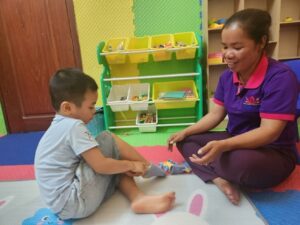
- Cognitive Testing: Evaluation of intellectual functioning, including problem-solving abilities, memory, and reasoning (e.g., IQ testing).
- Academic Performance Evaluations: Measurement of the child's performance in key academic areas such as literacy, numeracy, and comprehension.
- Speech and Language Assessments: Identification of challenges related to articulation, language development, expressive and receptive communication skills.
- Occupational or Physical Therapy Screenings: Assessment of fine and gross motor skills, sensory integration, coordination, and physical functioning.
- Development of the Individualized Education Plan (IEP) is a customized educational roadmap created for each child with identified special needs. It is developed collaboratively by a multidisciplinary team, including special education staff, therapists, classroom teachers, and the child’s parents or guardians, to ensure that the child receives appropriate, targeted support. Each IEP includes the following essential components:
- Present Level of Performance (PLOP): A comprehensive overview of the child's current academic achievement and functional abilities, identifying both strengths and areas of need.
- Specific and Measurable Goals: Clearly defined short-term and long-term learning goals that are individualized, attainable, and measurable, providing a basis for tracking progress.
- Required Support Services: A detailed list of specialized services the child needs, such as speech therapy, occupational therapy, physical therapy, or individualized special education instruction.
- Classroom Accommodations and Modifications: Adjustments to the learning environment, teaching methods, materials, or assessments to support the child’s success in both inclusive and specialized settings.
- Progress Monitoring and Review Timeline: A schedule outlining how the child’s progress toward IEP goals will be assessed and when the plan will be reviewed and revised, typically every 2 to 4 weeks or as needed.
- Implementation of Interventions and Services are delivered in either: Once the Individualized Education Plan (IEP) is developed, targeted interventions and support services are implemented based on each child's specific needs. These services are delivered through flexible and appropriate settings, including:
- Inclusive Classrooms: The child participates in general education classes with support from special education staff, allowing for social integration and collaborative learning.
- Pull-Out Sessions: The child receives individualized or small group instruction outside the regular classroom to focus on specific skills such as communication, literacy, or behavior management.
- Family Approach: all interventions are carefully monitored and regularly reviewed to ensure that they remain effective and aligned with the child’s Individualized Education Plan (IEP) Adjustments are made as needed, in close collaboration with the family, to promote steady progress and active family involvement in the child’s development.
- Ongoing Monitoring and Data Collection. To ensure the effectiveness of the Individualized Education Plan (IEP), teachers and specialists continuously monitor and document each child’s progress. This process helps guide instructional decisions and allows for timely adjustments to interventions and supports. Progress is tracked using a variety of tools and methods, including:
- Weekly or Monthly Observation Notes: Regular documentation of the child’s behavior, participation, and response to interventions in different learning environments.
- Skill Acquisition Checklists: Structured checklists used to record the development of specific skills related to cognitive, communication, behavioral, and self-care goals.
- Assessment Results and Student Work Samples: Periodic formal and informal assessments, along with samples of the child's work, are used to evaluate progress toward IEP goals.
- Regular Family Review Meetings (Every 1–2 Months): Collaborative meetings are held with parents or caregivers to review progress, discuss challenges, and revise the IEP as necessary to ensure it remains relevant and effective. This continuous monitoring process ensures that the educational program remains responsive, data-informed, and aligned with each child’s evolving needs.
- Transition and Long-Term Planning: As each child makes progress through the Special Education Program (SEP), careful planning is conducted to support their next phase of development. The goal is to ensure a smooth and successful transition that aligns with the child’s evolving abilities, interests, and future goals. The SEP team works closely with families and relevant professionals to develop a personalized transition plan, which may include:
- Reintegration into General Education: For students who meet age-appropriate academic and behavioral benchmarks, gradual reintegration into mainstream classrooms is facilitated with ongoing support.
- Transition to Vocational or Life-Skills Training (for Older Students): Older students may receive specialized instruction in practical skills, job readiness, and independent living to prepare for adulthood and workforce participation.
- Support for Independent Daily Living: Continued instruction in self-care, communication, mobility, and community participation to enhance the child’s autonomy and quality of life. A formal transition plan is developed for students nearing graduation or program completion, ensuring they are equipped with the resources, skills, and support networks needed to thrive beyond the school environment.
